Nursing Assignment: Comprehensive Questions on Wound Care and Nursing
VerifiedAdded on 2023/01/18
|10
|2053
|78
Homework Assignment
AI Summary
This nursing assignment provides a comprehensive overview of wound care, addressing various aspects from basic definitions to complex management strategies. The assignment begins with defining key terms such as acute and chronic wounds, exudate, epithelialization, and different types of infections. It explores the history of wound management, the role of the National Safety and Quality Health Service (NSQHS) Standards, and the causes of wounds, including both external and internal factors. The assignment then delves into fungal and bacterial infections, detailing causative organisms and treatment approaches. It also classifies surgical wounds and outlines the stages of pressure ulcers, venous ulcers, and arterial ulcers. Further, it covers different types of wound discharges, malignant and neuropathic ulcerations, and systemic infections resulting from wounds. Burn classifications and prevention strategies for burn wound infections are discussed, along with information on fistulas, sinuses, and skin grafts. The assignment concludes with a discussion of visceral wounds and the basic principles of wound management, including hemostasis, cleaning, analgesia, skin closure, and dressing. The references include key nursing textbooks and research articles to support the information provided.

Running head: QUESTIONS 1
Nursing assignment
Student details:
4/10/2019
Nursing assignment
Student details:
4/10/2019
Paraphrase This Document
Need a fresh take? Get an instant paraphrase of this document with our AI Paraphraser
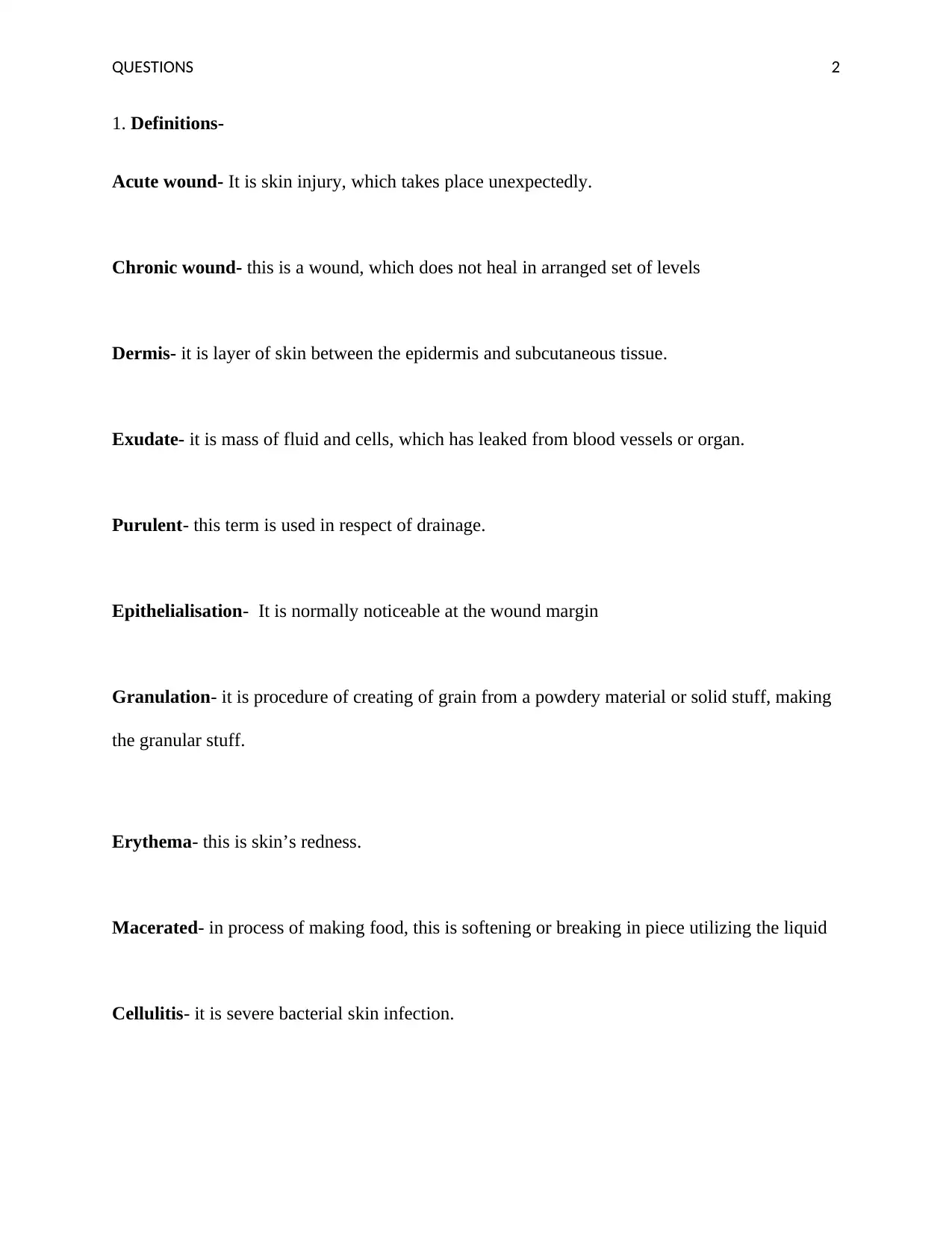
QUESTIONS 2
1. Definitions-
Acute wound- It is skin injury, which takes place unexpectedly.
Chronic wound- this is a wound, which does not heal in arranged set of levels
Dermis- it is layer of skin between the epidermis and subcutaneous tissue.
Exudate- it is mass of fluid and cells, which has leaked from blood vessels or organ.
Purulent- this term is used in respect of drainage.
Epithelialisation- It is normally noticeable at the wound margin
Granulation- it is procedure of creating of grain from a powdery material or solid stuff, making
the granular stuff.
Erythema- this is skin’s redness.
Macerated- in process of making food, this is softening or breaking in piece utilizing the liquid
Cellulitis- it is severe bacterial skin infection.
1. Definitions-
Acute wound- It is skin injury, which takes place unexpectedly.
Chronic wound- this is a wound, which does not heal in arranged set of levels
Dermis- it is layer of skin between the epidermis and subcutaneous tissue.
Exudate- it is mass of fluid and cells, which has leaked from blood vessels or organ.
Purulent- this term is used in respect of drainage.
Epithelialisation- It is normally noticeable at the wound margin
Granulation- it is procedure of creating of grain from a powdery material or solid stuff, making
the granular stuff.
Erythema- this is skin’s redness.
Macerated- in process of making food, this is softening or breaking in piece utilizing the liquid
Cellulitis- it is severe bacterial skin infection.
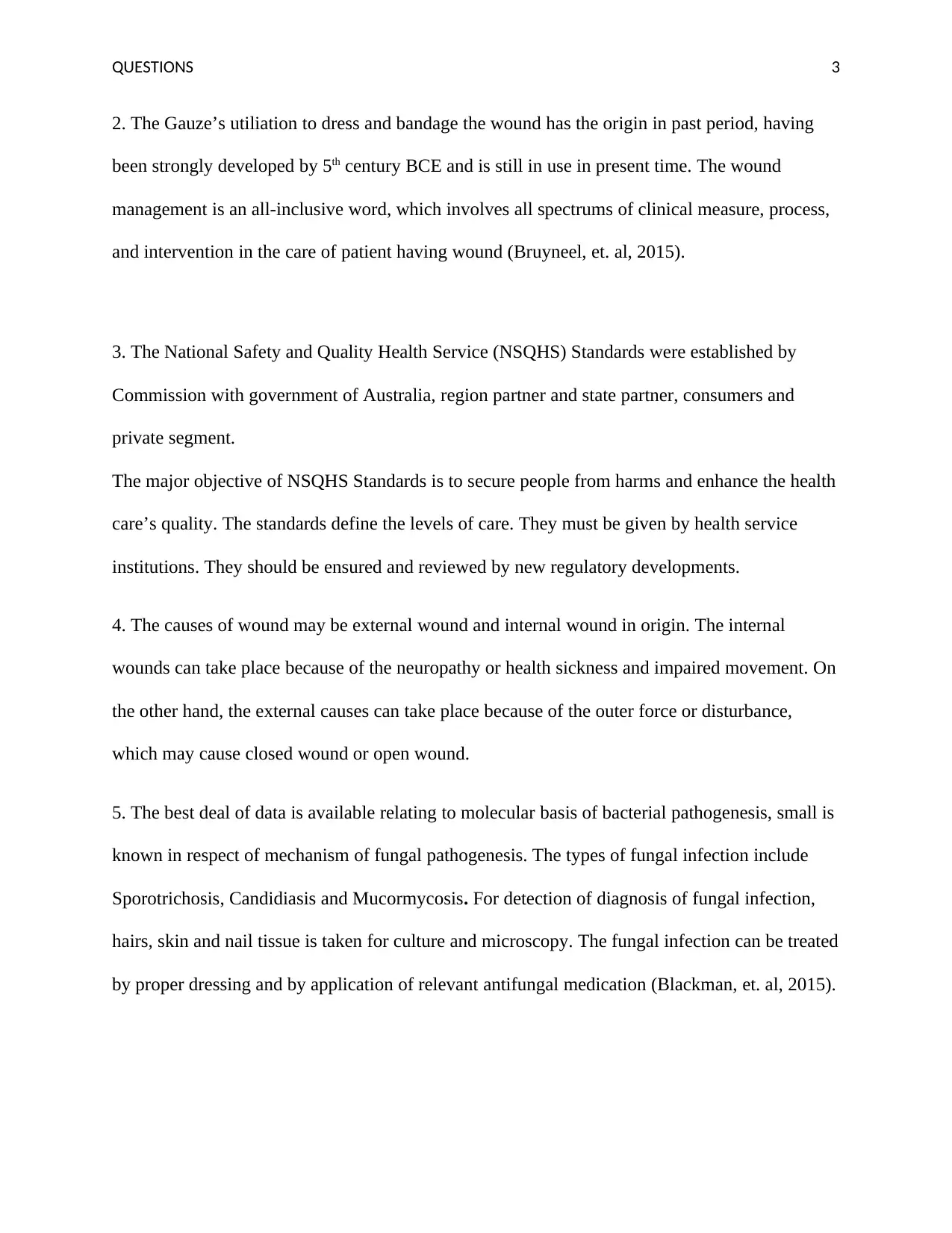
QUESTIONS 3
2. The Gauze’s utiliation to dress and bandage the wound has the origin in past period, having
been strongly developed by 5th century BCE and is still in use in present time. The wound
management is an all-inclusive word, which involves all spectrums of clinical measure, process,
and intervention in the care of patient having wound (Bruyneel, et. al, 2015).
3. The National Safety and Quality Health Service (NSQHS) Standards were established by
Commission with government of Australia, region partner and state partner, consumers and
private segment.
The major objective of NSQHS Standards is to secure people from harms and enhance the health
care’s quality. The standards define the levels of care. They must be given by health service
institutions. They should be ensured and reviewed by new regulatory developments.
4. The causes of wound may be external wound and internal wound in origin. The internal
wounds can take place because of the neuropathy or health sickness and impaired movement. On
the other hand, the external causes can take place because of the outer force or disturbance,
which may cause closed wound or open wound.
5. The best deal of data is available relating to molecular basis of bacterial pathogenesis, small is
known in respect of mechanism of fungal pathogenesis. The types of fungal infection include
Sporotrichosis, Candidiasis and Mucormycosis. For detection of diagnosis of fungal infection,
hairs, skin and nail tissue is taken for culture and microscopy. The fungal infection can be treated
by proper dressing and by application of relevant antifungal medication (Blackman, et. al, 2015).
2. The Gauze’s utiliation to dress and bandage the wound has the origin in past period, having
been strongly developed by 5th century BCE and is still in use in present time. The wound
management is an all-inclusive word, which involves all spectrums of clinical measure, process,
and intervention in the care of patient having wound (Bruyneel, et. al, 2015).
3. The National Safety and Quality Health Service (NSQHS) Standards were established by
Commission with government of Australia, region partner and state partner, consumers and
private segment.
The major objective of NSQHS Standards is to secure people from harms and enhance the health
care’s quality. The standards define the levels of care. They must be given by health service
institutions. They should be ensured and reviewed by new regulatory developments.
4. The causes of wound may be external wound and internal wound in origin. The internal
wounds can take place because of the neuropathy or health sickness and impaired movement. On
the other hand, the external causes can take place because of the outer force or disturbance,
which may cause closed wound or open wound.
5. The best deal of data is available relating to molecular basis of bacterial pathogenesis, small is
known in respect of mechanism of fungal pathogenesis. The types of fungal infection include
Sporotrichosis, Candidiasis and Mucormycosis. For detection of diagnosis of fungal infection,
hairs, skin and nail tissue is taken for culture and microscopy. The fungal infection can be treated
by proper dressing and by application of relevant antifungal medication (Blackman, et. al, 2015).
⊘ This is a preview!⊘
Do you want full access?
Subscribe today to unlock all pages.

Trusted by 1+ million students worldwide
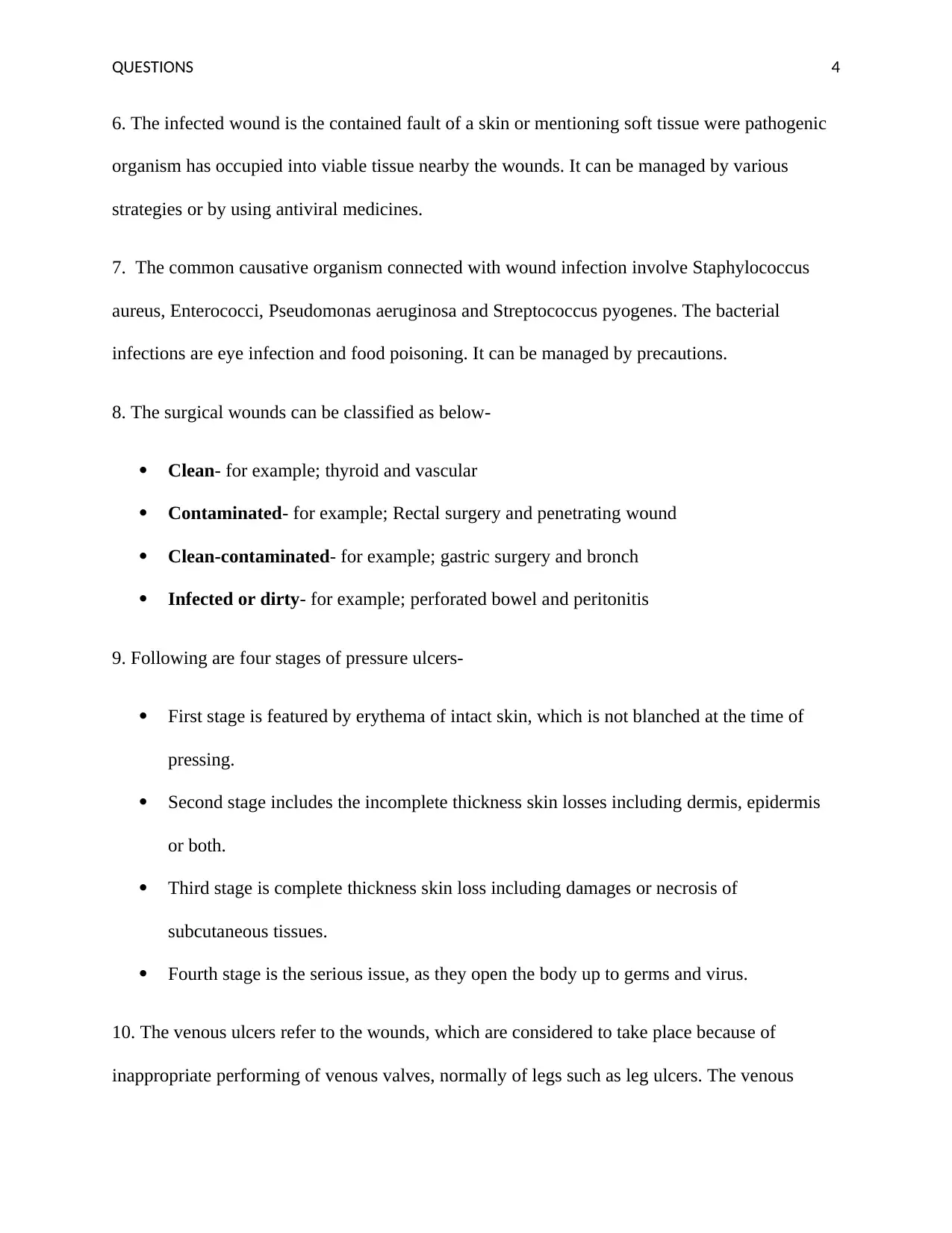
QUESTIONS 4
6. The infected wound is the contained fault of a skin or mentioning soft tissue were pathogenic
organism has occupied into viable tissue nearby the wounds. It can be managed by various
strategies or by using antiviral medicines.
7. The common causative organism connected with wound infection involve Staphylococcus
aureus, Enterococci, Pseudomonas aeruginosa and Streptococcus pyogenes. The bacterial
infections are eye infection and food poisoning. It can be managed by precautions.
8. The surgical wounds can be classified as below-
Clean- for example; thyroid and vascular
Contaminated- for example; Rectal surgery and penetrating wound
Clean-contaminated- for example; gastric surgery and bronch
Infected or dirty- for example; perforated bowel and peritonitis
9. Following are four stages of pressure ulcers-
First stage is featured by erythema of intact skin, which is not blanched at the time of
pressing.
Second stage includes the incomplete thickness skin losses including dermis, epidermis
or both.
Third stage is complete thickness skin loss including damages or necrosis of
subcutaneous tissues.
Fourth stage is the serious issue, as they open the body up to germs and virus.
10. The venous ulcers refer to the wounds, which are considered to take place because of
inappropriate performing of venous valves, normally of legs such as leg ulcers. The venous
6. The infected wound is the contained fault of a skin or mentioning soft tissue were pathogenic
organism has occupied into viable tissue nearby the wounds. It can be managed by various
strategies or by using antiviral medicines.
7. The common causative organism connected with wound infection involve Staphylococcus
aureus, Enterococci, Pseudomonas aeruginosa and Streptococcus pyogenes. The bacterial
infections are eye infection and food poisoning. It can be managed by precautions.
8. The surgical wounds can be classified as below-
Clean- for example; thyroid and vascular
Contaminated- for example; Rectal surgery and penetrating wound
Clean-contaminated- for example; gastric surgery and bronch
Infected or dirty- for example; perforated bowel and peritonitis
9. Following are four stages of pressure ulcers-
First stage is featured by erythema of intact skin, which is not blanched at the time of
pressing.
Second stage includes the incomplete thickness skin losses including dermis, epidermis
or both.
Third stage is complete thickness skin loss including damages or necrosis of
subcutaneous tissues.
Fourth stage is the serious issue, as they open the body up to germs and virus.
10. The venous ulcers refer to the wounds, which are considered to take place because of
inappropriate performing of venous valves, normally of legs such as leg ulcers. The venous
Paraphrase This Document
Need a fresh take? Get an instant paraphrase of this document with our AI Paraphraser
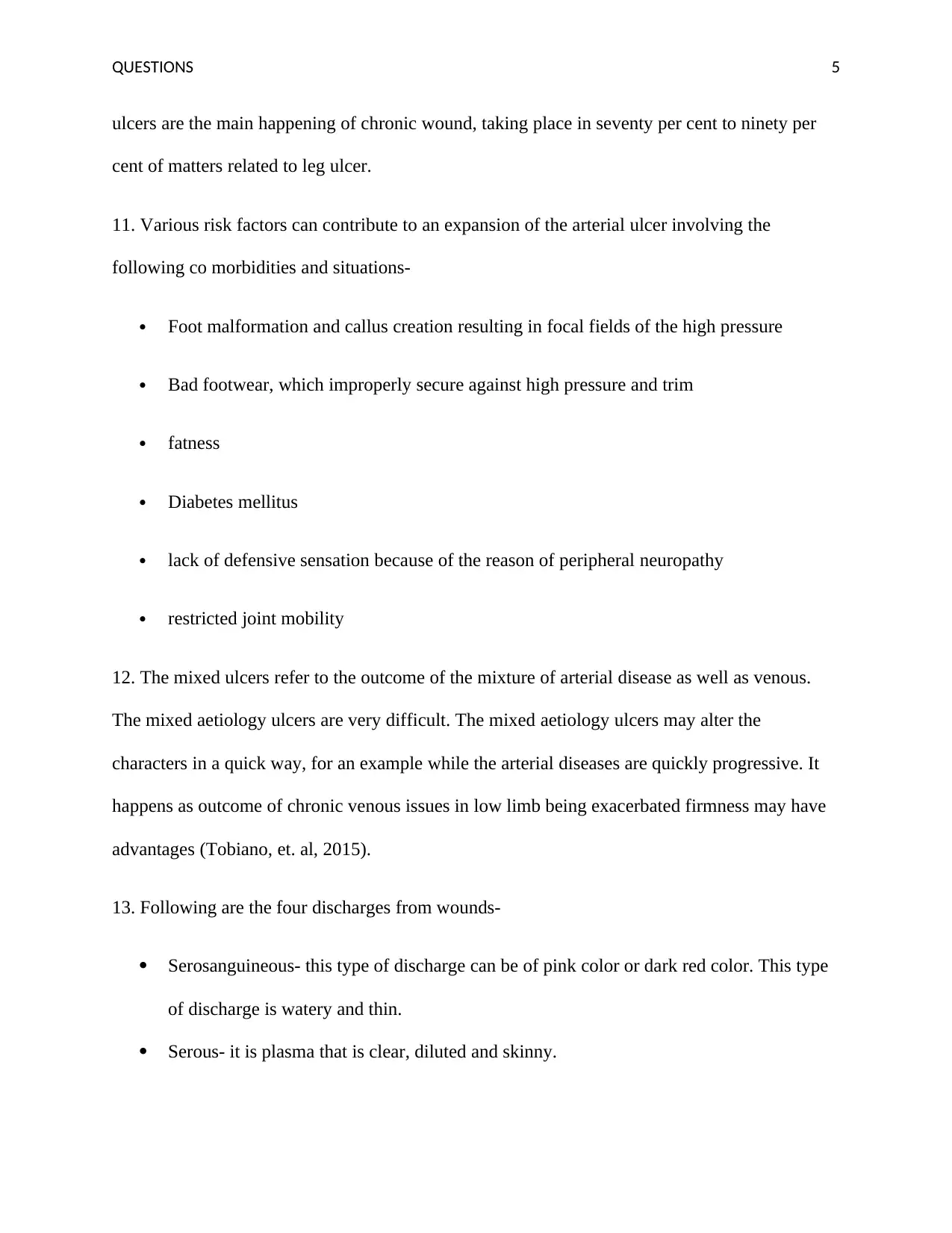
QUESTIONS 5
ulcers are the main happening of chronic wound, taking place in seventy per cent to ninety per
cent of matters related to leg ulcer.
11. Various risk factors can contribute to an expansion of the arterial ulcer involving the
following co morbidities and situations-
Foot malformation and callus creation resulting in focal fields of the high pressure
Bad footwear, which improperly secure against high pressure and trim
fatness
Diabetes mellitus
lack of defensive sensation because of the reason of peripheral neuropathy
restricted joint mobility
12. The mixed ulcers refer to the outcome of the mixture of arterial disease as well as venous.
The mixed aetiology ulcers are very difficult. The mixed aetiology ulcers may alter the
characters in a quick way, for an example while the arterial diseases are quickly progressive. It
happens as outcome of chronic venous issues in low limb being exacerbated firmness may have
advantages (Tobiano, et. al, 2015).
13. Following are the four discharges from wounds-
Serosanguineous- this type of discharge can be of pink color or dark red color. This type
of discharge is watery and thin.
Serous- it is plasma that is clear, diluted and skinny.
ulcers are the main happening of chronic wound, taking place in seventy per cent to ninety per
cent of matters related to leg ulcer.
11. Various risk factors can contribute to an expansion of the arterial ulcer involving the
following co morbidities and situations-
Foot malformation and callus creation resulting in focal fields of the high pressure
Bad footwear, which improperly secure against high pressure and trim
fatness
Diabetes mellitus
lack of defensive sensation because of the reason of peripheral neuropathy
restricted joint mobility
12. The mixed ulcers refer to the outcome of the mixture of arterial disease as well as venous.
The mixed aetiology ulcers are very difficult. The mixed aetiology ulcers may alter the
characters in a quick way, for an example while the arterial diseases are quickly progressive. It
happens as outcome of chronic venous issues in low limb being exacerbated firmness may have
advantages (Tobiano, et. al, 2015).
13. Following are the four discharges from wounds-
Serosanguineous- this type of discharge can be of pink color or dark red color. This type
of discharge is watery and thin.
Serous- it is plasma that is clear, diluted and skinny.

QUESTIONS 6
Sanguineous- This is the fresh blood, which is prevalent amongst deep wound of
complete and incomplete depth.
Purulent- one can be experiencing purulent discharge while a leakage from the wound
seems milky (Bragadóttir, Kalisch & Tryggvadóttir, 2017).
14. Malignant wound- Malignant wound is the result of cancerous cells sensitizing the skin and
the supporting blood and lymph vessel causing losses in vascularity may lead to tissue death. The
aim of care of malignant wound may move from healing to the palliative strategy, making focus
on three center principles. The symptom management is very significant principle. This is
followed by wound management and handling of an underlying tumor in a case where it is
proper and reasonable. Prior to making approach the care of malignant wound, to render practical
expectation, there is the requirement to state and end the disgrace.
15. Significant features of a neuropathic ulceration- the neuropathic ulceration is very useful and
effective in reducing the pressure on the unnatural (affected) areas. The neuropathic ulceration
prevents the skin damages occur at the initial stage. The neuropathic ulceration can be the helpful
attached in a supervision or execution of diabetic foot ulceration.
16. The wound infection may also cause systemic infection needing imperative interventions. On
the other hand, it happens while the body releases chemical in the blood to face infectivity, thus
reasoning the inflammatory reaction all through a body. Sepsis-related irritation may result in
wide array of bodily changes, which harm the organs.
17. The burn is categorized as first degree burn, second degree burn, or third-degree burn. First-
degree burn affects only the outer layer of the skin. This burn site is red. This is very throbbing,
dry, and without blister. Second-degree burn involves the portion of the skin’s dermis
Sanguineous- This is the fresh blood, which is prevalent amongst deep wound of
complete and incomplete depth.
Purulent- one can be experiencing purulent discharge while a leakage from the wound
seems milky (Bragadóttir, Kalisch & Tryggvadóttir, 2017).
14. Malignant wound- Malignant wound is the result of cancerous cells sensitizing the skin and
the supporting blood and lymph vessel causing losses in vascularity may lead to tissue death. The
aim of care of malignant wound may move from healing to the palliative strategy, making focus
on three center principles. The symptom management is very significant principle. This is
followed by wound management and handling of an underlying tumor in a case where it is
proper and reasonable. Prior to making approach the care of malignant wound, to render practical
expectation, there is the requirement to state and end the disgrace.
15. Significant features of a neuropathic ulceration- the neuropathic ulceration is very useful and
effective in reducing the pressure on the unnatural (affected) areas. The neuropathic ulceration
prevents the skin damages occur at the initial stage. The neuropathic ulceration can be the helpful
attached in a supervision or execution of diabetic foot ulceration.
16. The wound infection may also cause systemic infection needing imperative interventions. On
the other hand, it happens while the body releases chemical in the blood to face infectivity, thus
reasoning the inflammatory reaction all through a body. Sepsis-related irritation may result in
wide array of bodily changes, which harm the organs.
17. The burn is categorized as first degree burn, second degree burn, or third-degree burn. First-
degree burn affects only the outer layer of the skin. This burn site is red. This is very throbbing,
dry, and without blister. Second-degree burn involves the portion of the skin’s dermis
⊘ This is a preview!⊘
Do you want full access?
Subscribe today to unlock all pages.

Trusted by 1+ million students worldwide
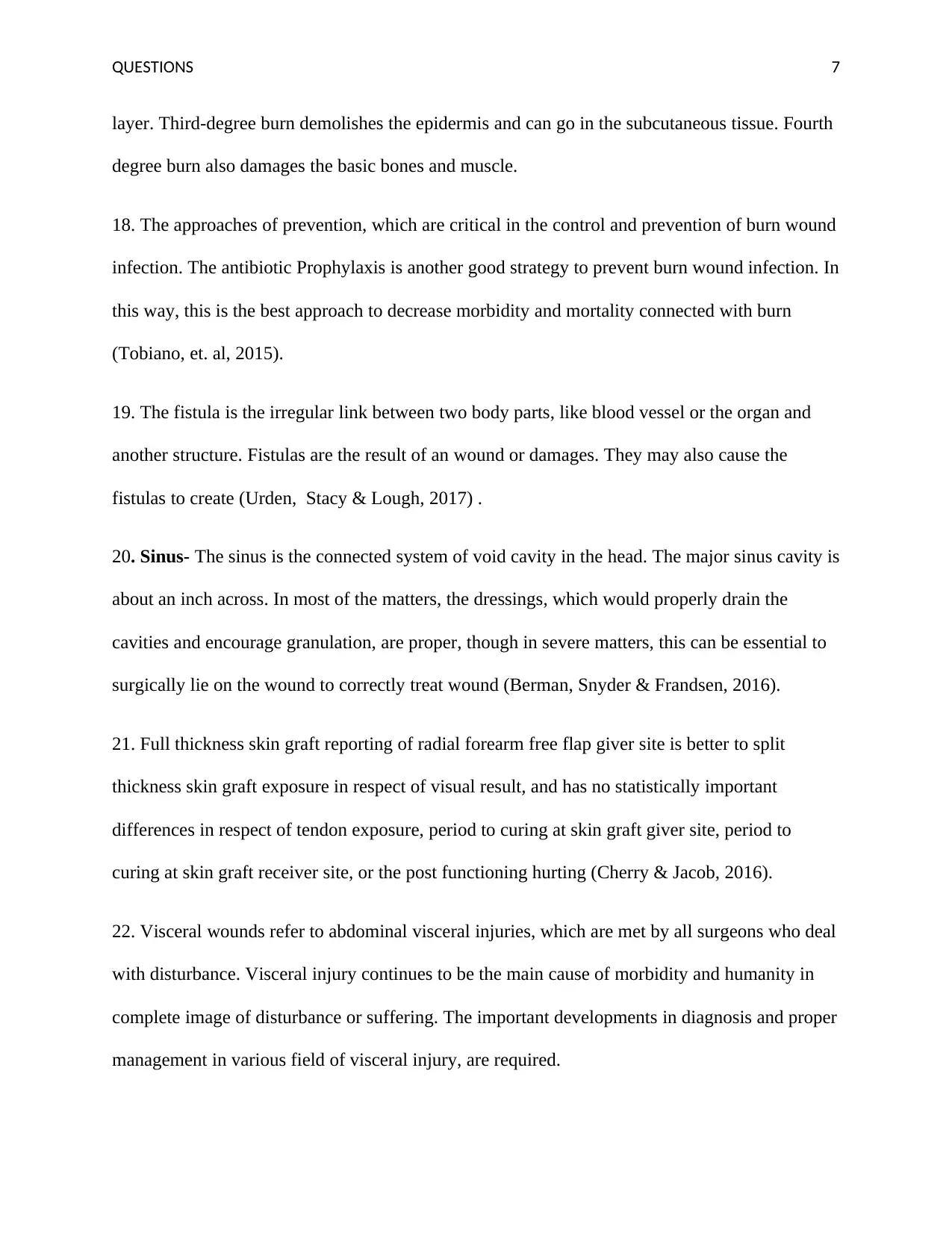
QUESTIONS 7
layer. Third-degree burn demolishes the epidermis and can go in the subcutaneous tissue. Fourth
degree burn also damages the basic bones and muscle.
18. The approaches of prevention, which are critical in the control and prevention of burn wound
infection. The antibiotic Prophylaxis is another good strategy to prevent burn wound infection. In
this way, this is the best approach to decrease morbidity and mortality connected with burn
(Tobiano, et. al, 2015).
19. The fistula is the irregular link between two body parts, like blood vessel or the organ and
another structure. Fistulas are the result of an wound or damages. They may also cause the
fistulas to create (Urden, Stacy & Lough, 2017) .
20. Sinus- The sinus is the connected system of void cavity in the head. The major sinus cavity is
about an inch across. In most of the matters, the dressings, which would properly drain the
cavities and encourage granulation, are proper, though in severe matters, this can be essential to
surgically lie on the wound to correctly treat wound (Berman, Snyder & Frandsen, 2016).
21. Full thickness skin graft reporting of radial forearm free flap giver site is better to split
thickness skin graft exposure in respect of visual result, and has no statistically important
differences in respect of tendon exposure, period to curing at skin graft giver site, period to
curing at skin graft receiver site, or the post functioning hurting (Cherry & Jacob, 2016).
22. Visceral wounds refer to abdominal visceral injuries, which are met by all surgeons who deal
with disturbance. Visceral injury continues to be the main cause of morbidity and humanity in
complete image of disturbance or suffering. The important developments in diagnosis and proper
management in various field of visceral injury, are required.
layer. Third-degree burn demolishes the epidermis and can go in the subcutaneous tissue. Fourth
degree burn also damages the basic bones and muscle.
18. The approaches of prevention, which are critical in the control and prevention of burn wound
infection. The antibiotic Prophylaxis is another good strategy to prevent burn wound infection. In
this way, this is the best approach to decrease morbidity and mortality connected with burn
(Tobiano, et. al, 2015).
19. The fistula is the irregular link between two body parts, like blood vessel or the organ and
another structure. Fistulas are the result of an wound or damages. They may also cause the
fistulas to create (Urden, Stacy & Lough, 2017) .
20. Sinus- The sinus is the connected system of void cavity in the head. The major sinus cavity is
about an inch across. In most of the matters, the dressings, which would properly drain the
cavities and encourage granulation, are proper, though in severe matters, this can be essential to
surgically lie on the wound to correctly treat wound (Berman, Snyder & Frandsen, 2016).
21. Full thickness skin graft reporting of radial forearm free flap giver site is better to split
thickness skin graft exposure in respect of visual result, and has no statistically important
differences in respect of tendon exposure, period to curing at skin graft giver site, period to
curing at skin graft receiver site, or the post functioning hurting (Cherry & Jacob, 2016).
22. Visceral wounds refer to abdominal visceral injuries, which are met by all surgeons who deal
with disturbance. Visceral injury continues to be the main cause of morbidity and humanity in
complete image of disturbance or suffering. The important developments in diagnosis and proper
management in various field of visceral injury, are required.
Paraphrase This Document
Need a fresh take? Get an instant paraphrase of this document with our AI Paraphraser
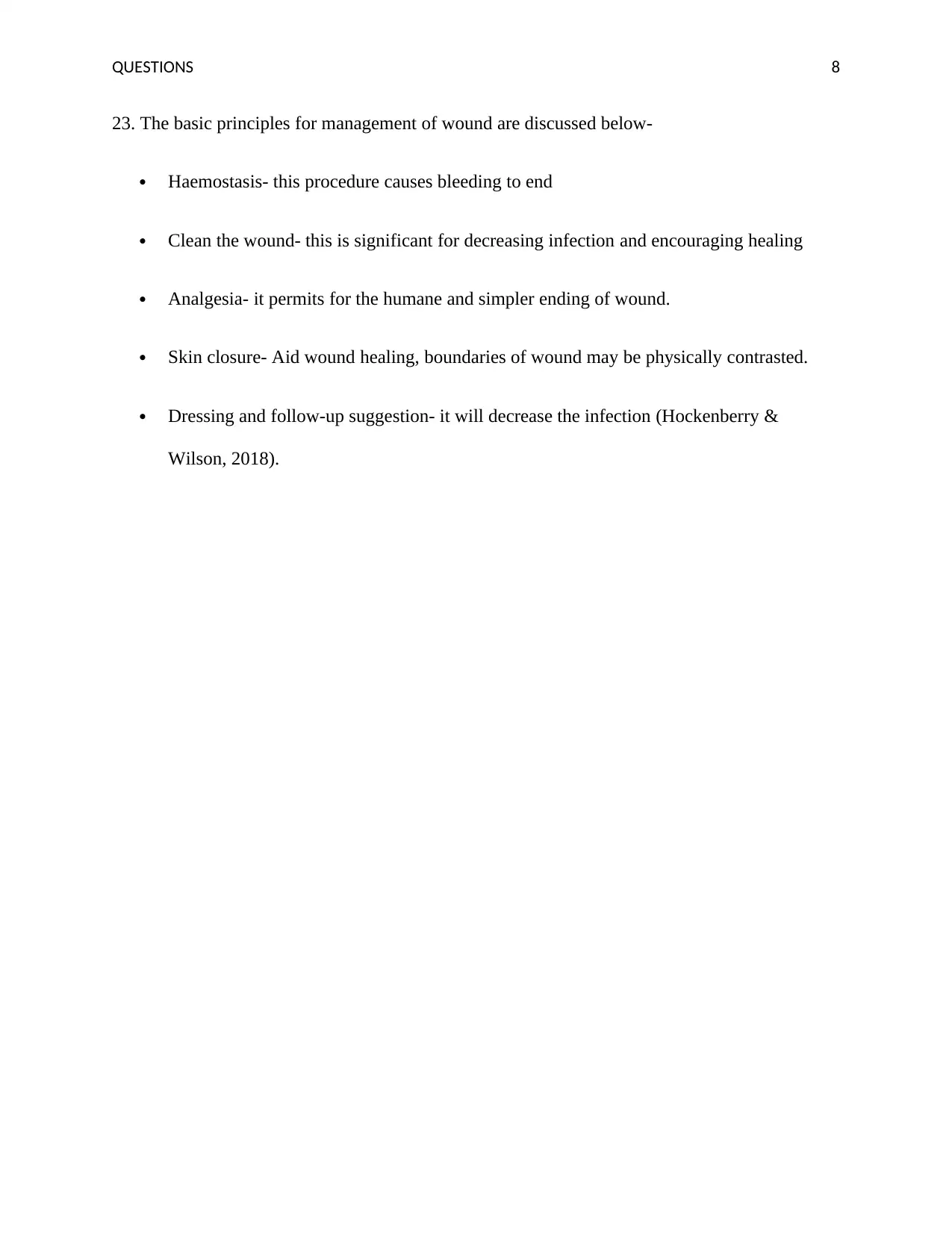
QUESTIONS 8
23. The basic principles for management of wound are discussed below-
Haemostasis- this procedure causes bleeding to end
Clean the wound- this is significant for decreasing infection and encouraging healing
Analgesia- it permits for the humane and simpler ending of wound.
Skin closure- Aid wound healing, boundaries of wound may be physically contrasted.
Dressing and follow-up suggestion- it will decrease the infection (Hockenberry &
Wilson, 2018).
23. The basic principles for management of wound are discussed below-
Haemostasis- this procedure causes bleeding to end
Clean the wound- this is significant for decreasing infection and encouraging healing
Analgesia- it permits for the humane and simpler ending of wound.
Skin closure- Aid wound healing, boundaries of wound may be physically contrasted.
Dressing and follow-up suggestion- it will decrease the infection (Hockenberry &
Wilson, 2018).
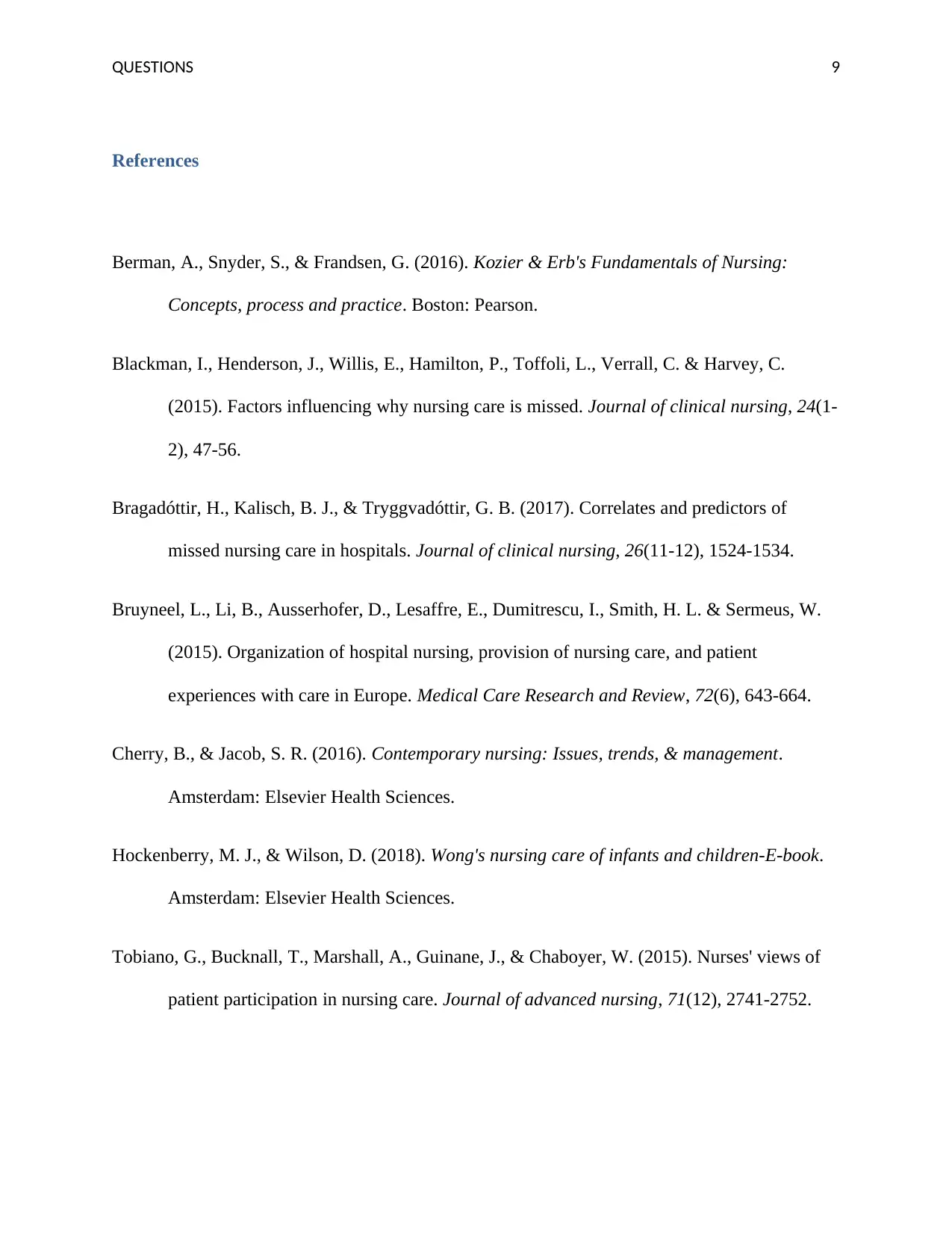
QUESTIONS 9
References
Berman, A., Snyder, S., & Frandsen, G. (2016). Kozier & Erb's Fundamentals of Nursing:
Concepts, process and practice. Boston: Pearson.
Blackman, I., Henderson, J., Willis, E., Hamilton, P., Toffoli, L., Verrall, C. & Harvey, C.
(2015). Factors influencing why nursing care is missed. Journal of clinical nursing, 24(1-
2), 47-56.
Bragadóttir, H., Kalisch, B. J., & Tryggvadóttir, G. B. (2017). Correlates and predictors of
missed nursing care in hospitals. Journal of clinical nursing, 26(11-12), 1524-1534.
Bruyneel, L., Li, B., Ausserhofer, D., Lesaffre, E., Dumitrescu, I., Smith, H. L. & Sermeus, W.
(2015). Organization of hospital nursing, provision of nursing care, and patient
experiences with care in Europe. Medical Care Research and Review, 72(6), 643-664.
Cherry, B., & Jacob, S. R. (2016). Contemporary nursing: Issues, trends, & management.
Amsterdam: Elsevier Health Sciences.
Hockenberry, M. J., & Wilson, D. (2018). Wong's nursing care of infants and children-E-book.
Amsterdam: Elsevier Health Sciences.
Tobiano, G., Bucknall, T., Marshall, A., Guinane, J., & Chaboyer, W. (2015). Nurses' views of
patient participation in nursing care. Journal of advanced nursing, 71(12), 2741-2752.
References
Berman, A., Snyder, S., & Frandsen, G. (2016). Kozier & Erb's Fundamentals of Nursing:
Concepts, process and practice. Boston: Pearson.
Blackman, I., Henderson, J., Willis, E., Hamilton, P., Toffoli, L., Verrall, C. & Harvey, C.
(2015). Factors influencing why nursing care is missed. Journal of clinical nursing, 24(1-
2), 47-56.
Bragadóttir, H., Kalisch, B. J., & Tryggvadóttir, G. B. (2017). Correlates and predictors of
missed nursing care in hospitals. Journal of clinical nursing, 26(11-12), 1524-1534.
Bruyneel, L., Li, B., Ausserhofer, D., Lesaffre, E., Dumitrescu, I., Smith, H. L. & Sermeus, W.
(2015). Organization of hospital nursing, provision of nursing care, and patient
experiences with care in Europe. Medical Care Research and Review, 72(6), 643-664.
Cherry, B., & Jacob, S. R. (2016). Contemporary nursing: Issues, trends, & management.
Amsterdam: Elsevier Health Sciences.
Hockenberry, M. J., & Wilson, D. (2018). Wong's nursing care of infants and children-E-book.
Amsterdam: Elsevier Health Sciences.
Tobiano, G., Bucknall, T., Marshall, A., Guinane, J., & Chaboyer, W. (2015). Nurses' views of
patient participation in nursing care. Journal of advanced nursing, 71(12), 2741-2752.
⊘ This is a preview!⊘
Do you want full access?
Subscribe today to unlock all pages.

Trusted by 1+ million students worldwide
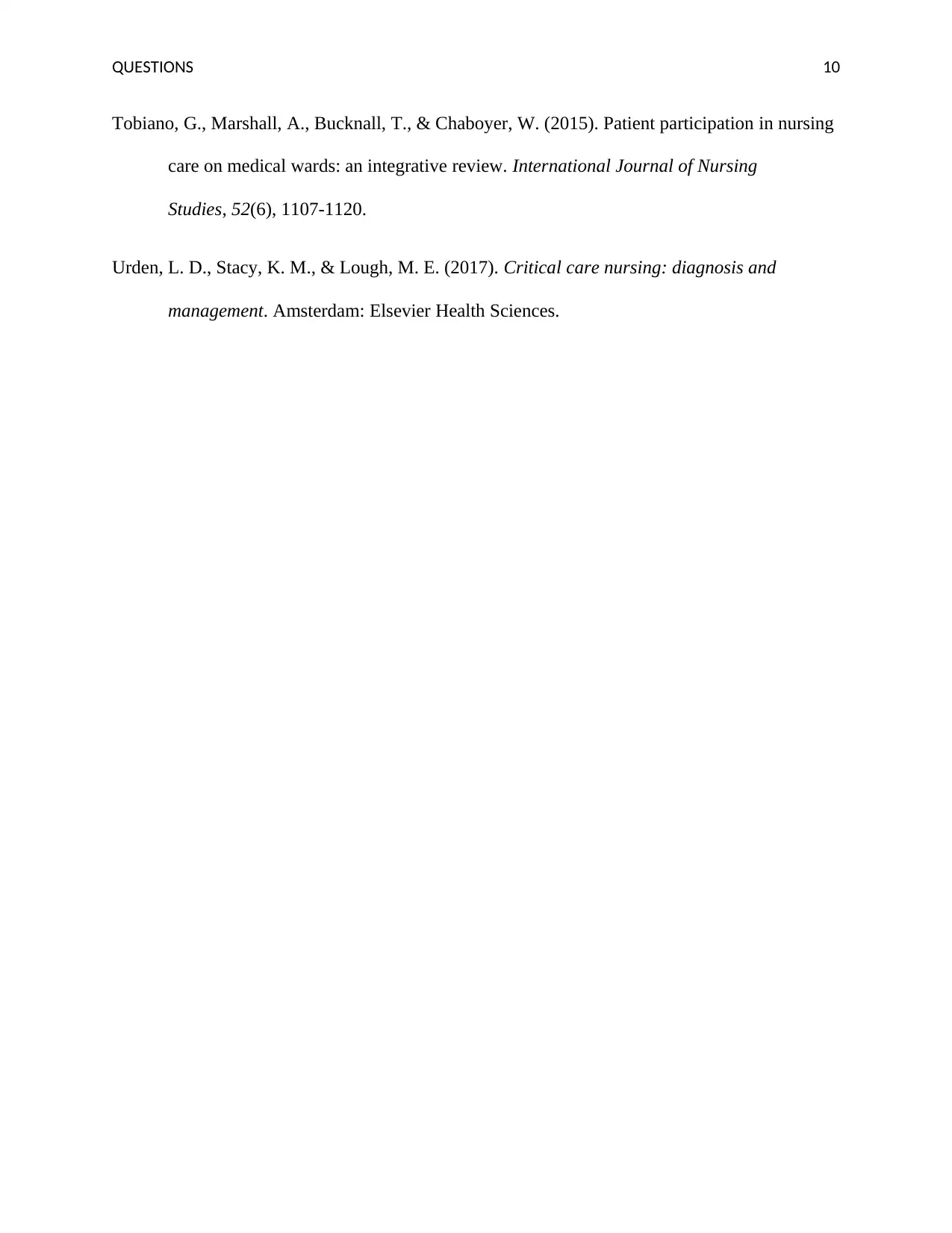
QUESTIONS 10
Tobiano, G., Marshall, A., Bucknall, T., & Chaboyer, W. (2015). Patient participation in nursing
care on medical wards: an integrative review. International Journal of Nursing
Studies, 52(6), 1107-1120.
Urden, L. D., Stacy, K. M., & Lough, M. E. (2017). Critical care nursing: diagnosis and
management. Amsterdam: Elsevier Health Sciences.
Tobiano, G., Marshall, A., Bucknall, T., & Chaboyer, W. (2015). Patient participation in nursing
care on medical wards: an integrative review. International Journal of Nursing
Studies, 52(6), 1107-1120.
Urden, L. D., Stacy, K. M., & Lough, M. E. (2017). Critical care nursing: diagnosis and
management. Amsterdam: Elsevier Health Sciences.
1 out of 10
Related Documents
Your All-in-One AI-Powered Toolkit for Academic Success.
+13062052269
info@desklib.com
Available 24*7 on WhatsApp / Email
![[object Object]](/_next/static/media/star-bottom.7253800d.svg)
Unlock your academic potential
Copyright © 2020–2025 A2Z Services. All Rights Reserved. Developed and managed by ZUCOL.





